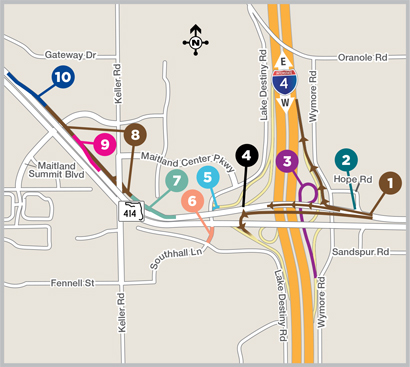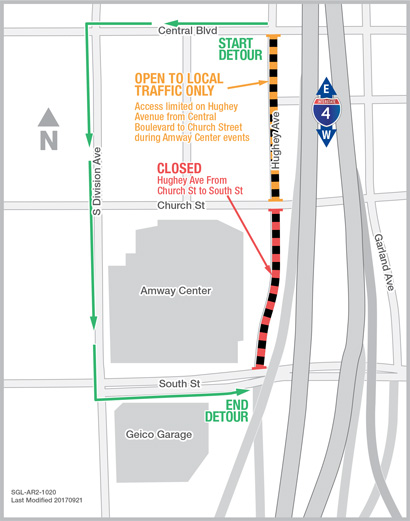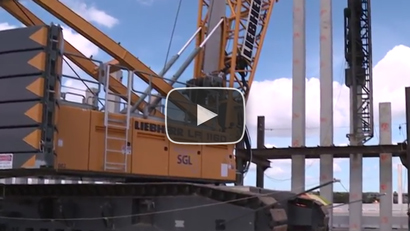|
|
|
|
Traffic Shift on WB Maitland Blvd. Scheduled for Sept. 24
|

|
| 1 |
Westbound Maitland Boulevard motorists heading to westbound I-4 must be in the left lane. Westbound Maitland Boulevard motorists heading to eastbound I-4 or continuing on westbound Maitland Boulevard must be in the right lane. |
| 2 |
Traffic signal added the intersection of Hope Road and westbound Maitland Boulevard. Traffic signal will allow motorists from Hope Road to safely cross westbound Maitland Boulevard to proceed to the westbound I-4 on-ramp. |
| 3 |
New permanent, elevated eastbound I-4 exit ramp to westbound Maitland Boulevard is approximately one-tenth of a mile sooner. |
| 4 |
The traffic signal at the end of the westbound I-4 exit ramp to westbound Maitland Boulevard (Exit 90B) is removed and the ramp is now free flowing onto westbound Maitland Boulevard. |
| 5 |
Left turn is added to southbound Lake Destiny Road 5 from westbound I-4 exit ramp (Exit 90C). |
| 6 |
Access to westbound Maitland Boulevard from Lake Destiny Road is eliminated. Motorists traveling on Lake Destiny Road who wish to enter westbound Maitland Boulevard are encouraged to either use Maitland Center Parkway or Southhall Lane to enter via Keller Road. |
| 7 |
Motorists traveling on westbound Maitland Boulevard that want to exit to use Keller Road will exit onto a new ramp that will allow access to northbound or southbound Keller Road. |
| 8 |
Motorists on Keller Road can follow signage to a frontage road which provides access to westbound Maitland Boulevard or Maitland Summit Boulevard. |
| 9 |
Motorists traveling on westbound Maitland Boulevard may exit on a new ramp to a frontage road leading to Maitland Summit Boulevard. |
| 10 |
Motorists from the frontage road or Maitland Summit Boulevard can follow signs to get onto westbound Maitland Boulevard. |
|
Westbound Maitland Boulevard (State Road 414) is shifting to its final configuration on a newly constructed elevated roadway this weekend.
The westbound Maitland Boulevard shift will affect traffic patterns at the Interstate 4 (I-4) interchange and intersections of Hope Road, Lake Destiny Road, Keller Road and Maitland Summit Boulevard. The new configuration eliminates traffic signals on the elevated stretch of westbound Maitland Boulevard between I-4 and Maitland Summit Boulevard alleviating congestion. New access ramps from westbound Maitland Boulevard will provide access to Keller Road and Maitland Summit Boulevard. Other major changes in traffic patterns as part of the traffic shift include:
- From Maitland Avenue, westbound Maitland Boulevard motorists heading to westbound I-4 must be in the left lane. Westbound Maitland Boulevard motorists heading to eastbound I-4 or continuing on westbound Maitland Boulevard must be in the right lane.
- A new traffic signal at intersection of Hope Road and westbound Maitland Boulevard will allow motorists from Hope Road to safely cross westbound Maitland Boulevard to proceed to the westbound I-4 on-ramp.
- The eastbound I-4 exit to westbound Maitland Boulevard (Exit 90B) will shift to the new ramp. The exit point on eastbound I-4 is approximately one-tenth of a mile sooner.
- The traffic signal at the end of the westbound I-4 exit ramp to westbound Maitland Boulevard (Exit 90B) will be removed and the ramp will be free flowing onto the new westbound Maitland Boulevard.
View or download a detailed online map of the traffic shift at: http://fdot.tips/WBMaitlandShift.
To view or download a handout detailing how Maitland Boulevard and the I-4 interchange will look upon project completion, please visit: http://fdot.tips/Maitland.
|
|
|
Long-Term Closure of Hughey Avenue Set for Early October
|

|
Hughey Avenue from Church Street to South Street is closing for approximately one year beginning as soon as early October.
The closure will provide a safe work zone for I-4 Ultimate crews to construct the new westbound I-4 exit ramp to State Road (S.R.) 408.
The intersections of Church Street and South Street will remain open for vehicles and pedestrians to travel across Hughey Avenue. A covered pedestrian walkway will be constructed on Church Street to allow pedestrians to safely cross through the construction area.
For motorists heading south on Hughey Avenue from Colonial Drive (S.R. 50), the detour around this closure will be:
- Right onto Central Boulevard
- Left onto Division Avenue
- Left onto South Street
For more information about parking and directions to the Amway Center, visit: http://www.amwaycenter.com/plan-your-visit/directions-parking.
|
|
|
Douglas Ave. Closure Set for Sept. 22-25; Wymore Rd. Closure Scheduled for Following Weekend
|

|
The I-4 Ultimate project is temporarily closing Douglas Avenue near State Road (S.R.) 436 beginning at 8 p.m. on Friday, September 22, until 6 a.m. on Monday, September 25.
The next weekend, Wymore Road will be closed near the intersection of Westmonte Drive. The Wymore Road closure will begin at 8 p.m. on Friday, September 29, and end by 6 a.m. on Monday, October 2.
The detour route for these closures is for motorists to use Westmonte Drive. To view or download a detour map of these closures, view: i4ultimate.com/DouglasWymore.
The closures are necessary to install new drainage pipes in the area. The work is in the beginning stages of transforming the Wymore Road, Douglas Avenue, S.R. 436 and Westmonte Drive intersections. Design enhancements in in this area will improve traffic flow and reinforce safety for both motorists and pedestrians traveling on and along S.R. 436. Learn more about upcoming changes also available at: i4ultimate.com/DouglasWymore.
|
|
|
Pile Driving Activity Varies throughout the I-4 Ultimate Project
|

|
They come in all different shapes, sizes and compositions, but all piles serve the same purpose: to support the massive structures throughout the I-4 Ultimate project.
Nearly 7,000 piles will be used to safely disperse weight from traffic and other structures, including about 140 bridges. Piles are long, vertical structures either made of steel or concrete that are placed deep into dense layers of the ground to support different kinds of structures.
Construction crews drive the pile into the ground using two methods. Vibratory pile driving is a high-frequency and low-impact method that uses a clamp that attaches to the top of the pile to vibrate and excite the soil around the pile. It displaces the loose and less dense soil and the pile gradually pushes down. Vibratory pile driving allows steel pile to get situated around 100 feet below the surface and it also is effective at installing sheet pile, which supports wall structures.
Impact hammer pile driving almost always follows vibratory pile driving for steel pile. Impact hammer pile driving is a high-impact and low frequency-method that uses a hammer to drive concrete pile and to drive steel pile through dense underground layers. It is used primarily when vibratory pile driving reaches a certain level.
People near pile driving activity may notice a vibration or a familiar pinging. Humans have a highly-sensitive vibration perception, and can feel pile driving anywhere from .006-.019 inches a second. Pile driving on the I-4 Ultimate project averages slightly over .2 inches a second, and generally does not occur at night, unless the activity is far from certain occupied buildings.
In an effort to mitigate disturbances to people nearby and still ensure accuracy, inspectors carefully monitor levels of vibration along with the amount of blows it takes to reach a certain level.
Vibration levels can be affected by a number of factors, including the type of soil, building structure and where a person is standing. Noise levels may be determined by proximity, level of sound dampening in a building and frequency. Generally, vibratory pile driving is less noisy than impact hammer pile driving.
Per construction contract terms, pile driving may only occur from 7 a.m. to 10 p.m.
For questions or concerns regarding pile driving activity, please visit: i4ultimate.com/public-outreach-education/contact-us/.
|
|
|
Spotlight Employee: Kevin Hayden
Kevin Hayden
FDOT Deputy Project Manager
Kevin Hayden is only three months into his new role as Florida Department of Transportation’s Deputy Project Manager, but he likes the change of pace and challenge it brings. “I wanted to explore new avenues,” he said.
Hayden is a geotechnical engineer, which is a civil engineering field that deals with foundations for roadways and bridges. When he saw that there was a position for deputy project manager, he applied. “The I-4 Ultimate project is something that I wanted to be involved with, and I was lucky enough to get the job,” he said.
As deputy project manager he helps resolve contractual issues and manages the oversight staff for construction, operations and maintenance of the project.
He originally wanted to become a doctor and started out as a biology major at Florida State University. “Somewhere along the way I decided to change course and ended up in civil engineering,” he said. “But because I’ve always had a fascination with the development of cities and roads, I felt like it was the right fit.”
Hayden grew up in Maitland and feels proud to be working on a project this big. He currently lives in DeLand with his wife and three young children. “It’s exciting to be a part of a project that’s so close to home,” he said. “Looking back, who knew after all these years travelling the interstate that I’d be a part of the team that reshapes I-4 and Central Florida.”
|
|
|
|
|
|
|
Public participation is solicited without regard to race, color, national origin, age, sex, religion, disability or family status. Persons who require special accommodations under the Americans with Disabilities Act or persons who require translation services (free of charge) should contact Jennifer Smith, FDOT Title VI Coordinator by phone at (386) 943-5367, or via email at jennifer.smith2@dot.state.fl.us. If you are hearing or speech impaired, please contact us by using the Florida Relay Service, 1-800-955-8771 (TDD) or 1-800-955-8770 (Voice).
|












